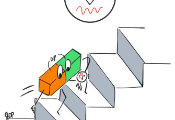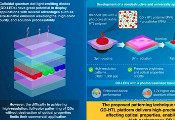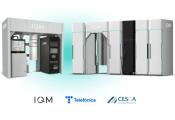Scientists Develop Cost-Effective Lasers for Extended SWIR Applications
December 10, 2024 -- A ground-breaking study published in Advanced Materials showcases a significant advancement in laser technology, promising more affordable and scalable solutions for applications ranging from environmental monitoring to biomedical imaging. Researchers have developed the first colloidal quantum dot (CQD)-based laser capable of operating across the entire extended short-wave infrared (SWIR) spectrum.
Current laser technologies for the extended SWIR spectral range rely on expensive and complex materials, limiting their scalability and affordability. To address these challenges, ICFO researchers Dr. Guy L. Withworth, Dr. Carmelita Roda, Dr. Mariona Dalmases, Dr. Nima Taghipour, Miguel Dosil, Dr. Katerina Nikolaidou, Hamed Dehghanpour, led by ICREA Prof. Gerasimos Konstantatos, have presented a novel approach based on colloidal quantum dots in an Advanced Materials article. The team managed to emit coherent light (a necessary condition to create lasers) in the extended SWIR range with large colloidal quantum dots made of lead sulfide (PbS).
This new CQD-based technology offers a solution to the aforementioned challenges while maintaining compatibility with silicon CMOS platforms (the technology used for constructing integrated circuit chips) for on-chip integration.
Their PbS colloidal quantum dots are the first semiconductor lasing material to cover such a broad wavelength range. Remarkably, the researchers accomplished this without altering the dots’ chemical composition. These results pave the way towards the realization of more practical and compact colloidal quantum dots lasers. Further to that, the team demonstrated lasing – for the first time in PbS quantum dots- with nanosecond excitation, replacing the need for bulky and costly femtosecond laser amplifiers. That was achieved by employing larger quantum dots, increasing thus the absorption cross-section of the dots tenfold, leading to a dramatic reduction in the optical gain threshold –the point at which the laser light emission becomes an efficient process.
The ability to produce low-cost, scalable infrared lasers in the extended SWIR range addresses critical bottlenecks in various technologies. This innovation has transformative potential for diverse applications, including hazardous gas detection, eye-safe LIDAR systems, advanced photonic integrated circuits, and imaging within the SWIR biological window. Industries relying on LIDAR systems, gas sensing, and biomedicine could greatly benefit from this cost-effective and integrable solution. Moreover, this breakthrough supports the transition to silicon-compatible photonic integrated circuits, enabling greater miniaturization and widespread adoption.
"Our work represents a paradigm shift in infrared laser technology," said ICREA Prof. Gerasimos Konstantatos. "For the first time, we’ve achieved lasing in the extended SWIR range with solution-processed materials at room temperature, paving the way for practical applications and the development of more accessible technologies."




































